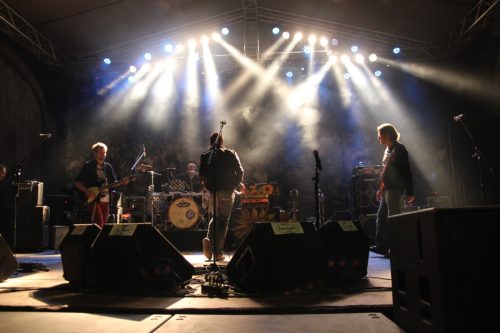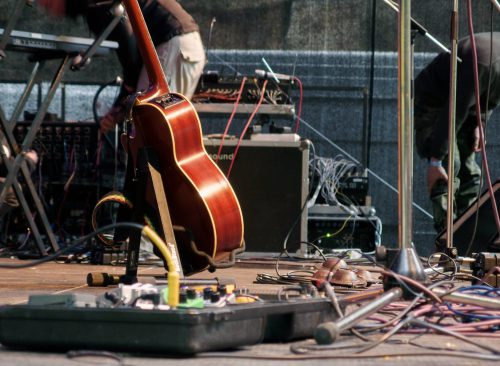Many famous musicians are known for their eccentricities, especially when performing live, in a variety of ways: quirky fashion, goofy antics, tangential improvisational playing that goes on and on for tens of minutes, and, of course, ornate stage décor.
This certainly includes all the seemingly decorative rugs that are so often laid down for people to play on. Aesthetics aside, Laying down rugs on stage does actually serve a few practical purposes as well.
Stage Rugs Help Keep Equipment From Sliding Around
Most stages have a hard floor with some kind of finish – durable, scuff resistant, and easier to clean and maintain, but not so good for keeping things firmly in place.
When snares and symbols are smacked and bass drums are thumped with a foot pedal, or a piano is played enthusiastically, or a standing instrument is leaned into, things slide, and this is not good for a multitude of reasons:
A drummer or guitarist can’t play on a kit or pedal board that’s getting constantly moved around and further away from them, obviously. Sound checking also, in many cases, is calibrated with pretty fair precision upon the expected location of musicians, their instruments, their speakers and amplifiers, etc.
Good rugs and pads help keep everything predictably in place.

Rugs Are Used to Manage Potential Tripping Hazards
People can accidentally slip and slide on a bare stage too, or trip on one of many necessary wires that need to be run and laid down, even when they are taped down.
Laying down a pad and rug helps prevent people from slipping and gives the roadies a place to run wire underneath in a way that’s both safer and more unobtrusive.

Rugs Help Absorb Exogenous Sound
Being able to properly hear oneself – and safely while minimizing hearing damage risk for that matter – is critical for playing well live. Ensuring this is a much more involved process than a lot of concert attendees might realize.
Monitoring speakers need to be carefully placed and calibrated, specialized earphones need to be worn, and so-called external noise needs to be mitigated.
Sound that reflects off a hard stage floor can be very loud, intrusively so, and interfere with a musician’s ability to properly hear themselves. Rugs and pads offer what’s called treatment, which basically means environmental adjustments to the room, stage, venue, or what have you to mitigate unwanted noise and/or resonance that can detract from the overall quality of sound and the ability to play optimally.
Stage Rugs for Musicians Are Easier to Stand on for Longer Periods of Time
Musicians need to be up and on their feet for pretty much the entirety of the performance, and they’re rarely wearing comfortable running shoes to their shows, but rather dressier shoes that either prioritize style or functionality for playing rather than comfort.
Rugs Help Maintain a Feeling of Familiarity
Talk to not just a musician but any athlete or other such performer and they will tell you that playing away from your “home turf” can significantly affect and even throw you off your game.
Anything you can do to make your playing environment as similar and consistent as possible when you’re touring from different venue to venue can help prevent that, and laying down familiar rugs is certainly one such way to do that.
Rugs Help Give the Stage a Warmer Look
Call it cozy, homey, intimate, whatever – there’s no doubt that a stage’s visual setting impacts the perception of a performance. Musicians can and will decorate their stages as a way to further immerse and draw their audiences in.
Live music is an interesting thing – the seemingly effortless or flowy aspects of a show are often actually planned with great precision, with a lot of no so obvious reasons for things being a certain way.

